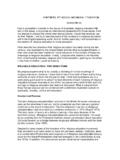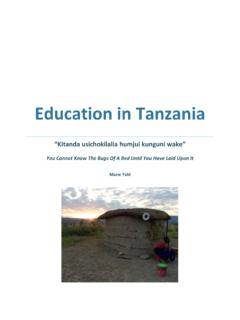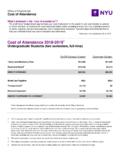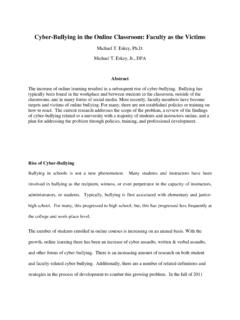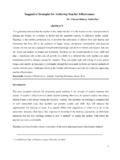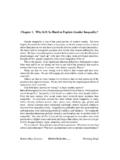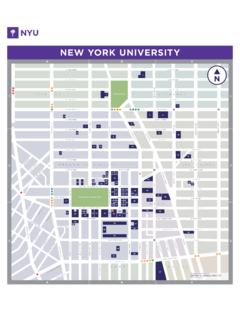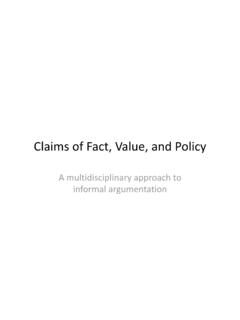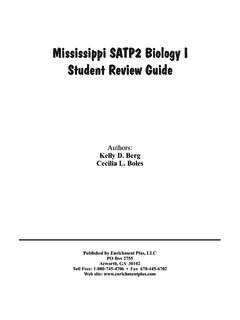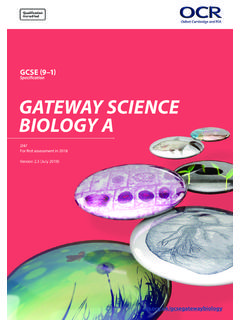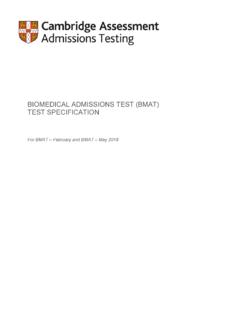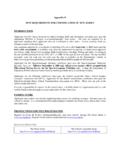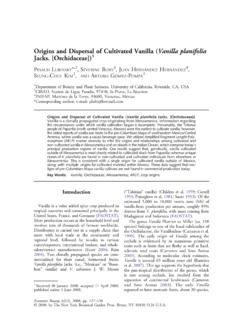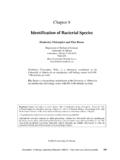Transcription of Molecular & Cell Biology - nyu.edu
1 Molecular & Cell BiologyLecture 1 2004 Prof. David FitchDepartment of BiologyNew York is life? Self-sustained heritability Functionality is limited by the genome Life cannot be explained entirely by functionality ("design") Why do snakes have femurs? Why do humans have 5 fingers per hand? Why do mitochondria and chloroplasts have their own rDNA and geneticcodes? Because of heredity, history is the explanation for current patterns "Historical constraint" (phylogenetic or genomic constraint) History of life = evolutionWhat is evolution? Evolution is a result: heredity + variation "Descent with modification" Fact: evolution has occurred Began as a hypothesis Not falsified, though falsifiable Theory: evolution is a body of explanatory principles Embodies a mechanism: natural selection, itself a result of: Variation in fitness (ability to survive to reproduce) Heredity (ability to pass alleles to progeny) Reproduction / multiplication (ability for population to grow) Explains a variety of phenomena Adaptations Shared nonadaptive features "Origin of species" vs.
2 Origin of life Difficulty of historical reconstruction increases with elapsed time Not possible to reconstruct actual events before heredity originatedOrigin of Life Precellular, Cellular Testing hypotheses A priori assumptions (often not stated) may themselves be tested Hypotheses must make falsifiable "predictions" "Null" hypothesis: chance alone is responsible Predictions are confirmed (consistent with) or refuted by data "Parsimony" distinguishes between alternative, unfalsified, workinghypotheses "Burden of proof" for less parsimonious (more complex) hypotheses Alternative hypotheses Intelligent design Least parsimonious (requires a creator) Lack of evidence for "design" does not falsify existence of intelligence Extraterrestrial origin Spontaneous self-organization and natural selection Also embodies many alternative hypothesesPrecellular evolution "Prebiotic synthesis" Hypothesis: The molecules of life can be formed spontaneouslyunder under "prebiotic conditions" Assumptions: Prebiotic conditions, "uniformitarianism" (NOT that humans should arise "continuously" from chimpanzees!)
3 Predictions Amino acids and purines from prebiotic mixtures (Harold & Urey 1953) Ribose from formaldehyde ("formose" reaction; Butlerow 1861) Polymerization of "activated" nucleoside monomers without proteins The "RNA World" Hypothesis: RNA preceded proteins and DNA as a primordial,information-bearing, catalytic molecule Assumptions: Heredity, uniformitarianism Predictions: Conserved roles for RNA in fundamental machinery of life At least some RNAs should demonstrate elementary catalytic activity Role for RNA as precursor to DNA may be conservedPrebiotic conditions?(a priori assumptions) Molecules (potentially available from atmosphere, deep oceanrifts, benthic clays) H2, CH4, NH3, CO, H2S Mineral catalysts (phosphorus, pyrite, clays) Energy potential sources (cal cm-2 yr-1) Solar x 105 UV at wavelengths: 300-400 x 103 250-300 x 102 200-250 x 101 <150 Electrical Shock Radiactivity8 x 101 x 10-1 Cosmic x 10-3 Reasonableenergylevels fororganicsynthesisOparin & Haldane (1920) hypothesis Hypothesis: The origin oflife was prebiotic Prediction: Molecules of lifeshould arise spontaneously inprebiotic conditions Test (Stanley Miller & HaroldUrey 1953) Results: >10% of C from CH4 was inorganic molecules These included amino acidsand precursors Amino acids (G, A, D, V, L) HCN and other cyanocompounds AldehydesPrecursors to amino acids "Strecker synthesis" Overall reaction: In atmosphere: In ocean.
4 Precursors to purinesPrecursors to ribose "Formose" synthesis (Butlerow 1861) Series of condensations beginning with formaldehyde2 HCOH(slow)Ribose-basednucleosideAcyclo-n ucleosidePhosphorylation would "activate" monomersOrigin of polymers Model for formation of RNA by activated , methylated nucleoside 5'-phosphorimidazolide:Chain length (poly-G)Without metalsWith Zn++Self-assembly of macromolecules Order and complexity result fromself-assembly Proteinoid microspheres with internalstructure Multisphere assemblages Membrane-like bilayers with"junctions" Novel microenvironments allow: Selective permeability via lipid or proteinoid "membranes" Novel (high) concentrations and enhancement of interactions Chained reactions (concentrated products available as substrates) Localized precipitation and organization (compartmentalization) Entropy can decrease in subsystems (not a violation of the 2ndLaw of Thermodynamics)"RNA World" hypothesisRNA preceded proteins & DNA (Orgel, Crick, Woese, 1960s) RNA has the essential role in peptide assembly mRNA, tRNA, rRNA (which can promote translation even missing some proteins) snRNAs ( , U1, U2, U4/6, U5) RNA is required for DNA replication and synthesis Primer RNAs required for DNA replication Telomerase RNA required for telomere synthesis Deoxyribonucleotides are derivatives of ribonucleotides Reverse transcriptase copies DNA from RNA template RNAs are key cofactors 7S RNA (protein secretion)
5 , ATP, Coenzyme A Some RNAs are catalytic Catalytic unit of RNase P (processes E. coli pre-tRNATyr) Self-splicing of introns Some RNAs are regulatory miRNAsGroup 1 self-splicing introns Processing occurs as a series of transesterificationsConservation of Group 1 introns Common ancestry allows comparative analysis of function Functionally important sequences/structures are often conserved Group 1 intron structures are conserved: in different genes in different species (slime molds, mitochondria, chloroplasts, somebacteriophageSome Gr. 1 introns encode maturases,and some encode endonucleases!Other introns Group 2 self-splicing a precursor to eukaryotic spliceosome? Note that Group 2 does not require a cofactor and makes a "lariat" Trans-splicing also occurs (all mRNAs of trypanosomes, many in C. elegans) Important implications for "exon shuffling"RNA as polymerase "L-19" RNA can direct template-dependent extension Depends only on availability of (spontaneous) oligosRNA as nuclease and ligase Nuclease activity is similar to splicing, but site-specific Ligase activity is energetically the reverseRNA as regulator of gene expressionAmbros, 2001(miRNA)"RNA World" hypothesisRNA preceded proteins & DNA (Orgel, Crick, Woese, 1960s) RNA has the essential role in peptide assembly mRNA, tRNA, rRNA (which can promote translation even missing some proteins) snRNAs ( , U1, U2, U4/6, U5) RNA is required for DNA replication and synthesis Primer RNAs required for DNA replication Telomerase RNA required for telomere synthesis Deoxyribonucleotides are derivatives of ribonucleotides Reverse transcriptase copies DNA from RNA template RNAs are key cofactors 7S RNA (protein secretion))
6 , ATP, Coenzyme A Some RNAs are catalytic Catalytic unit of RNase P (processes E. coli pre-tRNATyr) Self-splicing of introns Some RNAs are regulatory miRNAsRNA genome Early RNA genome could probably self-replicate Template-dependent synthesis, ligation Self-splicing would have allowed rapid evolution Different combinations of sequences and thus functions Early protein synthesis was directed by RNAs tRNAs, rRNA Early gene expression could be regulated by RNAs miRNAs Evolution of the Genetic Code Once the codons began to be set up, and complexity of the codeincreased, it would be difficult to change (historical constraint) Order to codon groupings suggests a possible stepwise adoption ofcodon codeGenetic code The code is "degenerate" Third codon position is often completely synonymous Perhaps the original machinery used only 1st & 2nd positions? Second position determines hydrophobicity/hydrophilicity If pyrimidine, codon is hydrophobic; if purine, codon is hydrophilic Easiest non-enzymatic RNA synthesis encodes proteinorder ( -sheets) : Heritable order is subject to Darwinian selection The stepwise process of selection will always lead to adaptations Novel features arise by (duplication and) modificationPrecellular evolution "Prebiotic synthesis" Hypothesis: The molecules of life can be formed spontaneouslyunder under "prebiotic conditions" Assumptions: Prebiotic conditions, "uniformitarianism" (NOT that humans should arise continuously from chimpanzees!)
7 Predictions Amino acids and purines from prebiotic mixtures (Harold & Urey 1953) Ribose from formaldehyde ("formose" reaction; Butlerow 1861) Polymerization of "activated" nucleoside monomers without proteins The "RNA World" Hypothesis: RNA preceded proteins and DNA as a primordial,information-bearing, catalytic molecule Assumptions: Heredity, uniformitarianism Predictions: Conserved roles for RNA in fundamental machinery of life At least some RNAs should demonstrate elementary catalytic activity Role for RNA as precursor to DNA may be conservedNext time Cellular evolution Molecular systematics The evolution of plastids Rooting the tree of life with gene duplications The evolution of introns: recent or ancient? Exon shuffling in the evolution of novel functions
